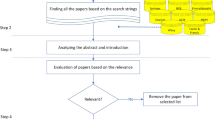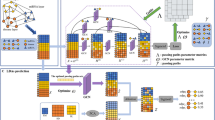Abstract
Link prediction problem in complex networks has received substantial amount of attention in the field of social network analysis. Though initial studies consider only static snapshot of a network, importance of temporal dimension has been observed and cultivated subsequently. In recent times, multi-domain relationships between node-pairs embedded in real networks have been exploited to boost link prediction performance. In this paper, we combine multi-domain topological features as well as temporal dimension, and propose a robust and efficient feature set called TMLP (Time-aware Multi-relational Link Prediction) for link prediction in dynamic heterogeneous networks. It combines dynamics of graph topology and history of interactions at dyadic level, and exploits time-series model in the feature extraction process. Several experiments on two networks prepared from DBLP bibliographic dataset show that the proposed framework outperforms the existing methods significantly, in predicting future links. It also demonstrates the necessity of combining heterogeneous information with temporal dynamics of graph topology and dyadic history in order to predict future links. Empirical results find that the proposed feature set is robust against longitudinal bias.









Similar content being viewed by others
Notes
If a conference A has taken place in multiple years, A represents the conference event as a whole, not each of its year-wise versions.
Typical value of the number of authors per scientific paper varies in the range of 2 −4 [14].
mean method forecasts the average value of data present in all windows.
R randomForest library is used with default parameters.
References
Aiello, L.M., Barrat, A., Schifanella, R., Cattuto, C., Markines, B., Menczer, F.: Friendship prediction and homophily in social media. ACM Trans. Web. 6(2), 9:1–9:33 (2012)
Dunlavy, D.M., Kolda, T.G., Acar, E.: Temporal link prediction using matrix and tensor factorizations. ACM Trans. Knowl. Discov. Data (TKDD) 5(2), 10 (2011)
Ermiṡ, B., Acar, E., Cemgil, A.T.: Link prediction in heterogeneous data via generalized coupled tensor factorization. Data Min. Knowl. Disc. 29(1), 203–236 (2015)
Hanley, J.A., Mcneil, B.J.: The meaning and use of the area under a receiver operating characteristic (ROC) curve. Radiology 143(1), 29–36 (1982)
Huang, Z., Li, X., Chen, H.: Link prediction approach to collaborative filtering. In: JCDL, pp. 141–142. ACM (2005)
Huang, Z., Lin, D.K.J.: The time-series link prediction problem with applications in communication surveillance. INFORMS J. Comput. 21(2), 286–303 (2009)
Hyndman, R., Koehler, A.B., Ord, J.K., Snyder, R.D.: Forecasting with exponential smoothing: the state space approach. Springer Series in Statistics. Springer (2008)
Krebs, V.E.: Mapping networks of terrorist cells. Connections 24(3), 43–52 (2002)
Liben-Nowell, D., Kleinberg, J.: The link-prediction problem for social networks. J. Am. Soc. Inf. Sci. Technol. 58(7), 1019–1031 (2007)
Lichtenwalter, R.N., Chawla, N.V.: Vertex collocation profiles: subgraph counting for link analysis and prediction. In: WWW, pp. 1019–1028. ACM (2012)
Lichtenwalter, R.N., Lussier, J.T., Chawla, N.V.: New perspectives and methods in link prediction. In: SIGKDD, pp. 243–252. ACM (2010)
Lü, L., Zhou, T.: Link prediction in complex networks: a survey. Physica A: Statistical Mechanics and its Applications 390(6), 1150–1170 (2011)
Murata, T., Moriyasu, S.: Link prediction of social networks based on weighted proximity measures. In: WI, pp. 85–88. IEEE Computer Society, Washington, DC, USA (2007)
Newman, M.E.J.: Scientific collaboration networks. i. network construction and fundamental results. Phys. Rev. 64, 016131 (2001)
Newman, M.E.J.: Scientific collaboration networks. II. Shortest paths, weighted networks, and centrality. Phys. Rev. E. 64, 016132 (2001)
Peña, D., Tiao, G.C., Tsay, R.S.: A course in time series analysis, vol. 322. Wiley (2011)
Potgieter, A., April, K.A., Cooke, R.J.E., Osunmakinde, I.O.: Temporality in link prediction: understanding social complexity. Emergence: Complexity & Organization (E: CO) 11(1), 69–83 (2009)
Richard, E., Gaïffas, S., Vayatis, N.: Link prediction in graphs with autoregressive features. J. Mach. Learn. Res. 15(1), 565–593 (2014)
Salton, G.: Automatic text processing: the transformation, analysis, and retrieval of information by computer. Addison-Wesley Longman Publishing Co. Inc. (1989)
Sett, N., Singh, S.R., Nandi, S.: Influence of edge weight on node proximity based link prediction methods: an empirical analysis. Neurocomputing 172, 71–83 (2016)
Sun, Y., Han, J., Aggarwal, C.C., Chawla, N.V.: When will it happen?: relationship prediction in heterogeneous information networks. In: WSDM, pp. 663–672. ACM (2012)
Tylenda, T., Angelova, R., Bedathur, S.: Towards time-aware link prediction in evolving social networks. In: SNA-KDD. ACM (2009)
Yang, Y., Chawla, N.V., Sun, Y., Han, J.: Predicting links in multi-relational and heterogeneous networks. In: ICDM, vol. 12, pp. 755–764 (2012)
Zhou, T., Lü, L., Zhang, Y.-C.: Predicting missing links via local information. The European Physical Journal B - Condensed Matter and Complex Systems 71(4), 623–630 (2009)
Author information
Authors and Affiliations
Corresponding author
Additional information
Saptarshi Basu was affiliated to Department of Computer Science and Engineering, Indian Institute of Technology Guwahati when this work was done.
Rights and permissions
About this article
Cite this article
Sett, N., Basu, S., Nandi, S. et al. Temporal link prediction in multi-relational network. World Wide Web 21, 395–419 (2018). https://doi.org/10.1007/s11280-017-0463-z
Received:
Revised:
Accepted:
Published:
Issue Date:
DOI: https://doi.org/10.1007/s11280-017-0463-z




